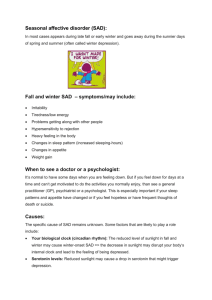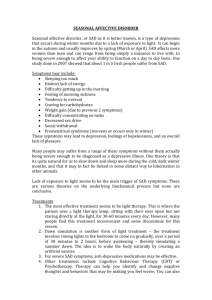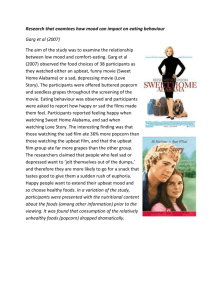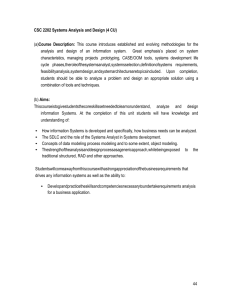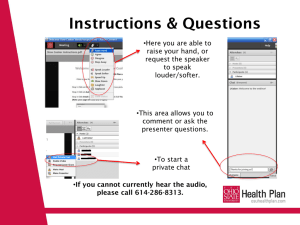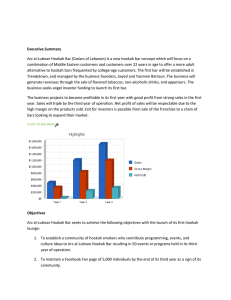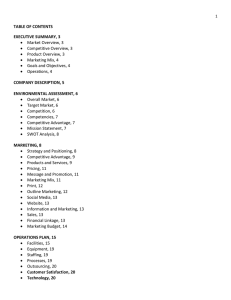Seasonal Student Issues
advertisement
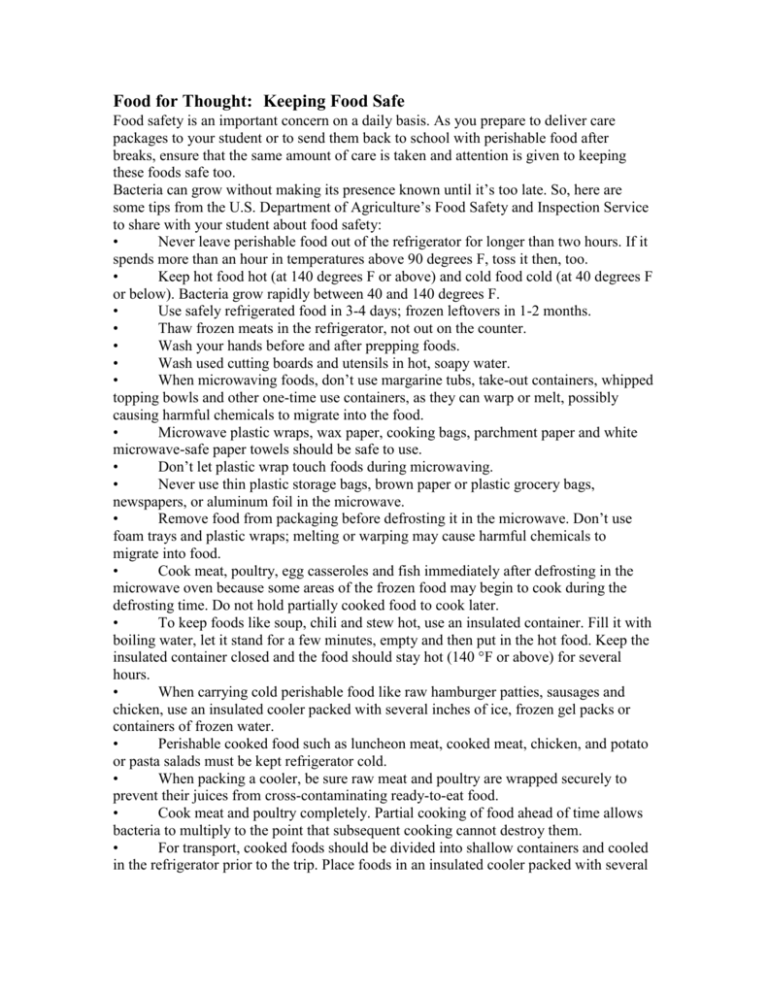
Food for Thought: Keeping Food Safe Food safety is an important concern on a daily basis. As you prepare to deliver care packages to your student or to send them back to school with perishable food after breaks, ensure that the same amount of care is taken and attention is given to keeping these foods safe too. Bacteria can grow without making its presence known until it’s too late. So, here are some tips from the U.S. Department of Agriculture’s Food Safety and Inspection Service to share with your student about food safety: • Never leave perishable food out of the refrigerator for longer than two hours. If it spends more than an hour in temperatures above 90 degrees F, toss it then, too. • Keep hot food hot (at 140 degrees F or above) and cold food cold (at 40 degrees F or below). Bacteria grow rapidly between 40 and 140 degrees F. • Use safely refrigerated food in 3-4 days; frozen leftovers in 1-2 months. • Thaw frozen meats in the refrigerator, not out on the counter. • Wash your hands before and after prepping foods. • Wash used cutting boards and utensils in hot, soapy water. • When microwaving foods, don’t use margarine tubs, take-out containers, whipped topping bowls and other one-time use containers, as they can warp or melt, possibly causing harmful chemicals to migrate into the food. • Microwave plastic wraps, wax paper, cooking bags, parchment paper and white microwave-safe paper towels should be safe to use. • Don’t let plastic wrap touch foods during microwaving. • Never use thin plastic storage bags, brown paper or plastic grocery bags, newspapers, or aluminum foil in the microwave. • Remove food from packaging before defrosting it in the microwave. Don’t use foam trays and plastic wraps; melting or warping may cause harmful chemicals to migrate into food. • Cook meat, poultry, egg casseroles and fish immediately after defrosting in the microwave oven because some areas of the frozen food may begin to cook during the defrosting time. Do not hold partially cooked food to cook later. • To keep foods like soup, chili and stew hot, use an insulated container. Fill it with boiling water, let it stand for a few minutes, empty and then put in the hot food. Keep the insulated container closed and the food should stay hot (140 °F or above) for several hours. • When carrying cold perishable food like raw hamburger patties, sausages and chicken, use an insulated cooler packed with several inches of ice, frozen gel packs or containers of frozen water. • Perishable cooked food such as luncheon meat, cooked meat, chicken, and potato or pasta salads must be kept refrigerator cold. • When packing a cooler, be sure raw meat and poultry are wrapped securely to prevent their juices from cross-contaminating ready-to-eat food. • Cook meat and poultry completely. Partial cooking of food ahead of time allows bacteria to multiply to the point that subsequent cooking cannot destroy them. • For transport, cooked foods should be divided into shallow containers and cooled in the refrigerator prior to the trip. Place foods in an insulated cooler packed with several inches of ice, frozen gel packs or containers of frozen water—or freeze the foods prior to the trip. Just be sure to refrigerate it as soon as you arrive. Source: www.fsis.usda.gov/ Fact_Sheets/Food_Safety_Tips_for_ College_Students/ Safe As Is Foods that don’t need refrigeration or careful packaging, according to the USDA, include: √ dehydrated foods √ beef jerky and other dried meats √ dried noodles and soups √ peanut butter in plastic jars √ canned ham, chicken, beef and tuna √ concentrated juice boxes √ dried fruits and nuts √ powdered milk and fruit drinks Seasonal Student Issues There’s a seasonal ebb and flow when it comes to student issues. Here are a few things your student may be experiencing this month: November • Roommate problems and floor tension • Academic pressures due to procrastination, workload and lack of ability • Burnout • Not feeling like they have the stamina to keep up the pace through finals • Job search stress for holiday break • Problems from increased alcohol consumption • Lack of initiative to find new friends or activities because it seems social groups are set up • Concerns about going home at Thanksgiving time—whether it’s concern about seeing changes among old friends, how things will be with family members or dealing with a romantic relationship Six Ways to Encourage Your Student to Stay Abreast of World News It’s so easy to get caught up in the campus bubble when you live on campus! You can help your student stay in touch with the world through these simple methods… Send an email newswire with selected clips each week. This is easier than you think. All you need to do is complete a quick search on the Internet for the top news stories of the week. Then, you can either scan the articles briefly and provide a quick synopsis with the link to the full story or just include the headline with the link. Put three or four stories in one email and send it along. Surprise your student with a magazine subscription. Get a magazine subscription to Time or Newsweek for your student and have it delivered directly to him on campus. Although it can be tough for students to find time to read “extras” during the school year, it’s important! Even a quick scan is better than not knowing about anything. Create an Internet scavenger hunt. Find some interesting news articles on a variety of websites. Challenge your student to find answers to a list of questions about these articles. You can even set it up so she can complete it with friends. Tell your student you’ll even provide the winner with a surprise treat in the mail! Plan a conversation dinner. If you live close to campus, invite your student and some of his friends home for dinner and discuss a topic in the news. If you don’t live close, offer to provide the funds for the group to go out for a meal, as long as they promise to discuss current events. Send news clippings. Whether it’s something from your hometown paper or the Boston Globe, get your student reading—and learning—by cutting out interesting articles and sending them her way every few weeks. Listen and share together. Plan to listen to National Public Radio or download a podcast on an important topic and then discuss what you heard afterwards. You can even “share” coffee and doughnuts from afar by both planning to purchase some good treats before you get on the phone together. The Season of SAD Seasonal Affective Disorder (SAD) As winter approaches, you may be noticing your student going through a change. Does she lack energy or seem sluggish? Has he withdrawn socially or lost interest in his work and activities? Is she sleeping more? This can often be attributed to seasonal affective disorder (SAD), a form of depression that occurs in relation to the seasons, most commonly beginning in winter. This is more than “cabin fever” —SAD sufferers exhibit symptoms of depression profound enough to affect school, work and their relationships. It can sometimes progress to major depression while in others, the symptoms resolve themselves with the change of seasons. Who Suffers from SAD? SAD generally begins in adolescence or early adulthood. It occurs more frequently in women than in men. Evidence suggests that SAD is more frequent among people who live further from the equator. And, while winter onset SAD is most common, there is also a less common form that comes about in spring or summer. Possible Causes The specific causes of SAD are unknown, but there are several possibilities: • It is possible that the reduced level of sunlight in the fall and winter disrupts the circadian rhythm. Disturbances in the body’s sleep/wake regulations may cause depression. • The body’s production of melatonin increases during the winter months. Melatonin has been linked to depression, and an excess of this hormone may be a factor. • Reduced sunlight can also cause a drop in serotonin, the brain chemical that affects mood. This can also lead to depression. Diagnosis SAD is generally diagnosed as a subtype of depression or bipolar disorder. Usually, SAD will be diagnosed if: • The person has experienced the symptoms of depression for two years or more, but only during a certain season • These periods of depression are followed by periods of non-depression • There are no other explanations for the change in mood or behavior (substance abuse, increased stress or problems, physical illness, etc.) Treatment Options Some of the treatment options available to people with SAD include: • Antidepressants • Talk therapy • Spending more time outdoors or near a window at home, school or work • Light therapy using a special lamp to mimic the spectrum of light from the sun. This is often the main treatment for people with SAD. They’ll sit a few feet from one of these specialized lamps so they are exposed to very bright light, which mimics outdoor light and causes a biochemical change in the brain that will lift their moods. As with any mental health concern, people with SAD need professional help. If your student seems to be experiencing any of the symptoms above, encourage him to seek out a campus counselor’s expertise. Sources: www.nimh.nih.gov/medlineplus/ency/article/001532.htm; www.mayoclinic.com/health/seasonal-affectivedisorder/DS00195/DSECTION=symptoms; www.mayoclinic.com/health/seasonalaffective-disorder/DS00195/DSECTION=causes; www.mayoclinic.com/ health/seasonalaffective-disorder/DS00195/DSECTION=treatments%2Dand%2Ddrugs; www.sltbr.org/sadfaq.htm Based on research by Jessica Polledri, PaperClip Communications Symptoms of Winter Onset SAD √ Depression with the onset of fall or winter √ Lack of energy √ Decreased interest in work or significant activities √ Increased appetite and weight gain √ Carbohydrate cravings √ Increased sleep and excessive daytime sleepiness √ Social withdrawal √ Afternoon slumps with decreased energy and concentration √ Slow, sluggish, lethargic movement The Hookah Hook Hookahs, or water pipes, that are popular in the Middle East, North Africa, and Central and South Asia, are now finding a place among students in the United States. A recent study at the University of Pittsburgh School of Medicine—the first random sample study of U.S. students focused on hookah smoking—found that 41% of the 647 students surveyed had smoked tobacco from a hookah. And 78.8% of that group thought hookah smoking was less addictive than cigarettes. In the same study, 39.6% of students had smoked cigarettes at least once. And 35.4% of students who smoked tobacco in a hookah had never smoked cigarettes. That has researchers concerned. “I think that’s a key finding,” Dr. Brian Primack, lead author of the study and an assistant professor of medicine and pediatrics at Pitt’s medical school, told the Chicago Sun-Times (9/7/08). “There’s an overlap in a lot of people (who have smoked both) but there were over a third of the people smoking water pipes who would otherwise have never touched a cigarette… (Hookahs) are reaching a group of young people who otherwise would have been nicotine- and tobacco-naive… We don’t really know what the implication of that is. Some people might say that it wouldn’t make a difference: Somebody who is exposed to a few water pipe sessions, that might not change their risk of later using tobacco products. But I think there are a lot of researchers who would be concerned and say that even intermittent exposure at this age to nicotine and tobacco will increase their likelihood of becoming addicted to nicotine and continuing to the same.” Shisha, the hookah tobacco that is often flavored with molasses, dried fruit or honey, is often thought to be less harmful than cigarette tobacco. This isn’t the case, according to the American Cancer Society. On its website, it says, “Hookahs are marketed as being a safe alternative to cigarettes. This claim is false. The water does not filter out many of the toxins. In fact, hookah smoke has been shown to contain concentrations of toxins, such as carbon monoxide, nicotine, ‘tar’ and heavy metals, that are as high or higher than are seen with cigarette smoke.” Source: Chicago Sun-Times, 9/7/08; American Cancer Society, www.cancer.org Hookah Facts • Also called narghile (nar-guh-lee) smoking • Involves burning a tobacco mixture that has been mixed with flavors such as honey, molasses or dried fruit in a water pipe and inhaling the flavored smoke through a long hose • Charcoal is usually used to heat the tobacco mixture, known as shisha • Hookah smoking is often a social event which allows the smokers to spend time together and talk as they pass the pipe around Source: American Cancer Society, www.cancer.org This American Cancer Society event is scheduled for Nov. 20, 2008. Find out more at www.cancer.org/ docroot/subsite/ greatamericans/ Smokeout.asp. American Indian Proverbs There are plenty of proverbs that can really make us think—people often tend to identify with these sayings. Get a book of Native American proverbs like Guy A. Zona’s The Soul Would Have No Rainbow if the Eyes Had No Tears and Other Native American Proverbs (1994) and find proverbs such as: • “Don’t let yesterday use up too much of today.” – Cherokee proverb • “Everyone who is successful must have dreamed of something.” – Maricopa proverb • “Knowledge that is not used is abused.” – Cree proverb • “If you see no reason for giving thanks, the fault lies within yourself.” – Minquass proverb • “We will be known forever by the tracks we leave.” – Dakota proverb November is American Indian Heritage Month. Take some time to remember all that Native Americans have contributed to U.S. culture this month—and beyond!
